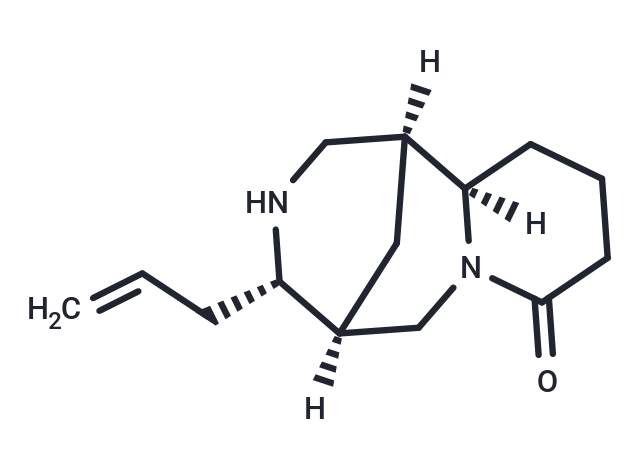Shopping Cart
- Remove All
 Your shopping cart is currently empty
Your shopping cart is currently empty

Angustifoline is a natural alkaloid isolated from Lupinus angustifolius L., exhibiting antimicrobial and anticancer properties. It inhibits the growth of various bacteria(S. aureus, B. subtilis, E. coli, P. aeruginosa and B. thuringiensis) and induces autophagy and apoptosis in human colon cancer cells.

| Pack Size | Price | Availability | Quantity |
|---|---|---|---|
| 5 mg | $1,268 | Backorder | |
| 1 mL x 10 mM (in DMSO) | $1,389 | Backorder |
| Description | Angustifoline is a natural alkaloid isolated from Lupinus angustifolius L., exhibiting antimicrobial and anticancer properties. It inhibits the growth of various bacteria(S. aureus, B. subtilis, E. coli, P. aeruginosa and B. thuringiensis) and induces autophagy and apoptosis in human colon cancer cells. |
| In vitro | Methods: Feeding inhibition was found in the alkaloid fraction of L. polyphyllus extracts. Eight lupin alkaloids present in the extracts were tested at a rate of 25 μg per feeding disk. Results: Among these compounds, 13-trans-cinnamoyloxylupanine and 13-tigloyloxylupanine showed strong inhibitory effects, while lupine, galactoline, 13-hydroxylupine, tetrahydrolupine, Angustifoline, and 17-oxolupanine showed no inhibitory effects. Four alkaloids not present in L. polyphyllus, namely lupine, epilupine, α-isolupine, and lupinyl trans-cinnamate, were inactive at 25 μg per feeding disk. |
| Molecular Weight | 234.34 |
| Formula | C14H22N2O |
| Cas No. | 550-43-6 |
| Smiles | O=C1N2[C@@]([C@]3(C[C@@](C2)([C@H](CC=C)NC3)[H])[H])(CCC1)[H] |
| Relative Density. | 1.10 g/cm3 (Predicted) |
| Storage | Powder: -20°C for 3 years | In solvent: -80°C for 1 year | Shipping with blue ice. |

Copyright © 2015-2025 TargetMol Chemicals Inc. All Rights Reserved.